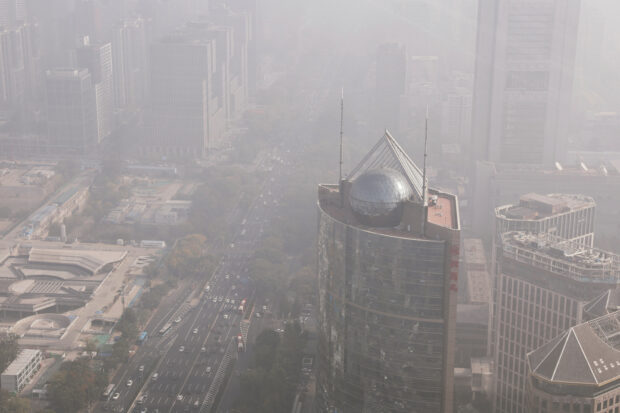China set for sudden change of climate from warm to freezing

Cars move on a street in Beijing’s Central Business District (CBD) as the city is shrouded in smog in China on November 1, 2023. REUTER/Tingshu Wang
BEIJING — Temperatures in northern China are set to plunge as much as 20 degrees Celsius after the second-warmest October in decades, but warmer-than-usual conditions could soon be back under the influence of El Niño.
A stream of cold air entering China on Saturday from the northwest will join one that arrived on Thursday to push temperatures sharply lower, the China Meteorological Administration (CMA) said.
In the sparsely populated deserts and grasslands of the northern Inner Mongolia region, temperatures could plummet on Friday and again from Saturday while blizzards could hit the Xinjiang region in the northwest.
From next week, most of the northeast is expected to see maximum temperatures dive to the single-digits or below freezing as cold air moves east and south, in an abrupt reversal of a recent “big warming,” the CMA said.
READ: Millions of children displaced due to extreme weather events
Article continues after this advertisementWhile freezing temperatures are not uncommon for the time of year, the sudden change is unusual.
Article continues after this advertisementA few days ago, uncharacteristically warm weather saw parts of northern China post record high temperatures exceeding 30 degrees Celsius.
Weather has become more extreme in China in recent years, destroying urban infrastructure as well as farmland, causing hefty economic losses and raising fears about the pace and impact of global warming.
This summer, typhoons dumped historic rainfall in inland regions unaccustomed to tropical storms. Typhoon Doksuri caused the worst flooding since 1963 in the Hai river basin that encompasses Beijing, Tianjin, and Hebei province.
READ: Explainer: What caused the record rainfall in Beijing and northern China?
Authorities are due to issue 1 trillion yuan ($137 billion) of sovereign bonds to help rebuild areas hit by the floods and improve infrastructure to cope with disasters.
Earlier in the year, northern China basked in unseasonal heat, with temperatures reaching summer-levels, shortly after a very cold January, when the northernmost city of Mohe saw the temperature dip to a record minus 53 degrees Celsius.
Winter this year, however, could be warmer due to a moderate El Niño, Jia Xiaolong, deputy director of China’s National Climate Center, told a press conference on Friday.
READ: Scientists say cutting pollution accelerates climate change
El Niño is a natural climate pattern associated with warming of the ocean surface temperatures in the central and eastern Pacific. The phenomenon occurs every two to seven years, lasting nine to 12 months.
“The sea surface temperature in the east-central equatorial Pacific will continue to exceed 0.5C in November, and the El Niño event will persist in the 2023/2024 winter, with a peak intensity of 1.5-2C,” Jia said.
But statistics showed that winter temperatures could fluctuate greatly during El Niño, Jia warned.
($1 = 7.3127 Chinese yuan renminbi)